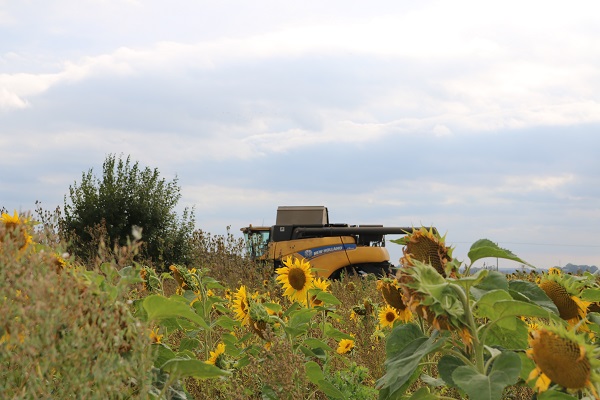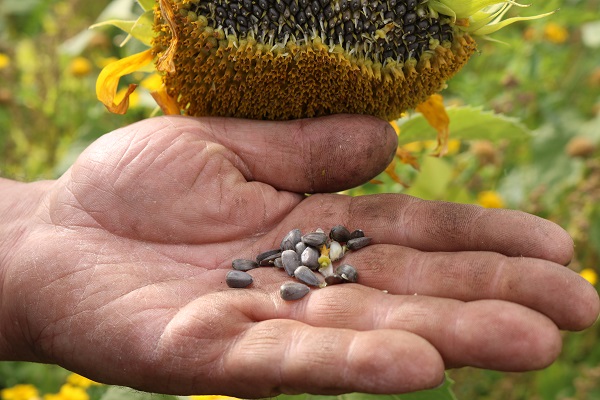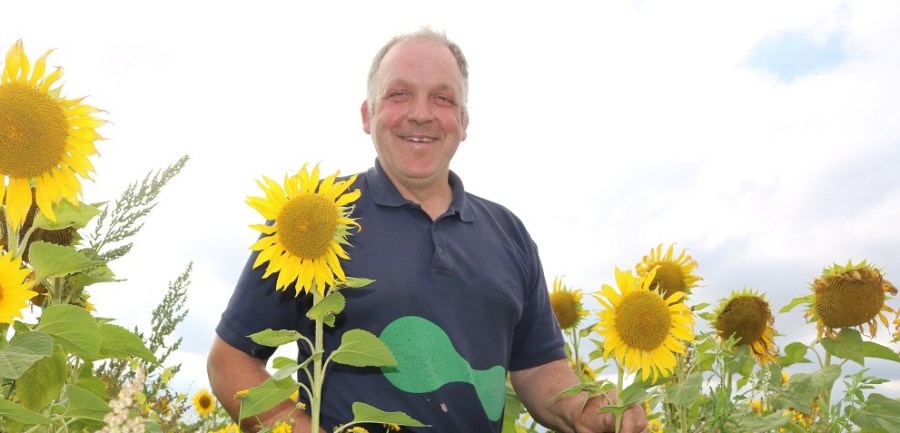For the past 13 years, work undertaken at Rawcliffe Bridge in E Yorks to develop understanding of how farming and wildlife interact may literally have helped shape agricultural policy. CPM visits the driving force behind it.
It’s a lot better to show someone how it’s done than to tell them.
By Tom Allen-Stevens
As we near the bottom corner of the field, heading towards the same point as the advancing combine, the crop suddenly bursts into life. A covey of grey partridge flutter, dash and tumble from the Fuego spring beans, making their way towards the relative refuge of the wild bird cover crops that surround the field edge.
From the combine, David Hinchliffe’s voice crackles over his brother’s walkie-talkie. “Look! There they are, James – there must be a good 20 of them. That’s a grand sight.” James Hinchliffe is clearly pleased. “You see something like that, or hear a skylark singing, and it brightens your day,” he beams.
But it’s no twist of fate that’s brought the birds to Rawcliffe Bridge near Goole in E Yorks. Since 2003, the family farming partnership has worked with BASF to monitor the farm’s wildlife and develop small changes in practice and specific seed mixtures that help encourage it.

Since 2003, the Hinchliffes have worked with BASF to monitor the farm’s wildlife and develop small changes in practice and specific seed mixtures that help encourage it.
“We were already doing on-farm trials with BASF, looking at the use of strobilurin fungicides, mainly,” explains James Hinchliffe. “For them, I guess it’s part of the work they’re doing globally to promote biodiversity. But I have a real interest in the farm’s wildlife, especially farmland birds, and I think you need that.”
Even within his own family business he admits he’s probably the one who drives that aspect forward. The partnership, including brother David and nephew Richard, farms a total of 560ha, based at Bank House Farm. Most of the land here is fine alluvial silt – warp land developed from carefully controlled flooding some 2-300 years ago. Nearby is Dikes Marsh Farm, with predominantly high magnesium clay, while there’s a sandy bar running through parts of the farmed area.
Winter wheat, oilseed rape and winter and spring beans rotate around the farm, with 10-12t/ha wheat crops the norm on the warp land, while the sandier soil suffers badly in drier years, notes James Hinchliffe. “This is where we’ve focused our environmental work – the wild bird cover crop areas are all in one 2ha block.”

Sunflowers tend to be the most popular – like the steak and chips of the bird-food world.
Baseline level
This work started with some monitoring – the first task was to assess a baseline level of wild birds, butterflies and moths, mainly. “I was fed up of people saying intensive farming on good land kills all the wildlife and was keen to show that wasn’t the case. Once we started looking for people who’d do the work, it’s surprising just how many interest groups there are, and we weren’t short of volunteers.
“As well as monitoring actual numbers, they ringed the birds to track migratory patterns – I never realised just how many birds are passing through the farm. It’s a population that’s constantly on the move.”
His main interest lies in what he calls “the true farmland birds” – yellow wagtails, skylarks, corn bunting, lapwing and grey partridge. “It’s interesting how numbers have fluctuated, and that can often have little to do with farming practice,” he explains.
“Lapwing and yellow wagtail seem to prefer min-till or no-till situations, and have benefited as we’ve gone down that route. Grey partridge are very weather dependent. Skylarks are holding their own – they like to get their territory and they’re there until they die. Corn bunting numbers have plummeted and we don’t know why. We didn’t have many in 2003, but we have very few now.”
Over the years, they’ve tried a number of practices on the farm and assessed what difference these may have made. Nesting boxes were introduced for tree sparrows, for example, and there are now 100 dotted around key areas of the farm.
“In the early years, we had great success with up to 80% occupancy. But then in 2008, numbers went down. They’re going up again gradually now, but it can be hard to know what’s driving it and whether you can influence the change.”
Other practices are more easy to explain. “We put up a dozen nesting boxes for owls and didn’t get a single barn owl. But tawny owls are dominant here – you get to understand the habits of your local wildlife.”
One practice that’s yielded surprisingly good results, however, is supplementary feeding. “The key period for farmland birds is Nov through to June. On a typical arable farm with winter cropping, there can be very little seed about for birds to forage. Even where you have a reasonable amount of hedgerow and wild bird cover, there’s a hungry gap from around Feb. In a harsh spring, grey partridge in particular can suffer,” explains James Hinchliffe.
“I’d heard of another farmer who’d carried on feeding through until June and tried it here. We scatter a bit of grain regularly on a hard track and the difference it makes is quite remarkable.”
But perhaps the main focus of the work at Rawcliffe has been the wild bird seed mixtures themselves. “In the first year, we established strips of individual plant types – about 18 in total. We monitored which birds favoured which strips and when they were foraged.”
Sunflowers tend to be the first to go, he reports. “Green and gold finches love them – it’s like the steak and chips of the bird-food world. Fodder radish is least liked, and can be left altogether. But it has its place – following a harsh winter, it can be the only seed available and a valuable lifeline.”
Some birds are drawn in by specific additions. “Gold finches and reed buntings are attracted by teasels – these have a small, hard-to-get seed that only particular birds will go for. They’re also favoured by a certain type of moth, and its larvae provide another valuable food source for birds.”
Different mixtures
Currently, different mixtures are grown in the strips. Along with sunflowers, teasels and fodder radish, mustard, chicory and phacelia are species that have done well and found favour with the birds and insects that thrive within them. “Borage is also good, but once you’ve grown it, you’ll never get rid of it,” notes James Hinchliffe.
About half of the patches are re-established each year. “They provide cover as well as food. They can look untidy, and my brother and father aren’t keen on them. But we also have a pollen-and-nectar strip right next to the road which can look stunning.
“That in itself has changed attitudes locally – I’ve had several offcomedens (townies) who’ve pulled off the road and asked about it. You get a greater respect when you pass people on the road in a tractor as a result.”
It’s the public relations potential of the work at Rawcliffe which hasn’t gone underplayed. It’s helped the farm host various local community groups and explain farming practices. Several ministers and MEPs have also visited, points out James Hinchliffe.
“There was a time when a Defra minister was here – the mustard was in full flower and covered in pollen beetle, which was a great opportunity to explain the balance farmers are trying to achieve. Then a flock of some 2-3000 swifts came over – it really was quite a sight and clearly made an impression on the minister, who had been quite a doubter to begin with. It’s a lot better to show someone how it’s done than to tell them.”
Some of the work has indeed directly influenced farming policy on the environment, he notes. “The difficulty I have with the Entry-Level Scheme is that if all you’re doing is putting field margins full of cocksfoot around fields, you’re achieving very little for biodiversity.”
A strong supporter of Brexit, he recognises it’ll result in a shift in farming policy, but doesn’t believe greater funding for environmental measures will bring best results. “Money isn’t the answer – you’re either keen on the environment or you’re not, and any amount of funding won’t change that.
“The environment is a nice-to-have, but public money should be spent on preserving vulnerable areas, such as the Uplands, and ensuring we can feed the nation. Arable farmers can cut their cloth accordingly, and it’ll be those of us who recognise the benefits of a diverse environment who’ll continue the good work.”
It’s not just about the birds – it’s about changing perception
Like many farmers, James Hinchliffe has recognised how low-yielding areas of the farm can deliver considerable benefits for wildlife, according to Graham Hartwell of BASF, who’s been closely involved with the work at Rawcliffe Bridge.
“But the real innovation here is how that’s been integrated with the farming system and how he’s harnessed the potential for those areas to help change public perception, and gain a closer understanding of how wildlife interacts with farming,” he says.
“What’s also of great value is how he’s tested locally the plant species that can work within field margins to increase biodiversity. When it comes to wildlife, a ‘one-size-fits-all’ approach is not the ideal solution and local experience is crucial.”
He reckons it sits well with the Hinchliffes’ desire to run a successful, sustainable family business. “They recognise that profitability is the first step to sustainability and that delivery of a sustainable biodiversity and protecting resources are key aspects of modern agriculture.”
But these theoretical aims need a practical touch to deliver results on farm, which allow for the farm location, soil type and weather conditions, he notes. “James’ way to create solutions to challenges is to innovate in a pragmatic way. Together we’ve come to decisions on how to progress the system through discussion, reflection and his no-nonsense approach to delivery, coupled with a drive to make things happen.”

This has helped the shared approach BASF has adopted with its involvement at Rawcliffe Bridge, he explains. “We work with independent experts, NGOs, NFU, water companies, universities and research organisations, among others, to ensure all decisions on farm are interrelated and fall within Integrated Farm Management concepts.
“The recognition that best practice agronomy can coexist with best practice biodiversity on a profitable modern farming system is a strong message for sustainability for BASF and its customers. We can demonstrate that to many of the influencer visitors to Rawcliffe.”
That means industry benefits, in terms of a better understanding at policy-generation level how the effects of government decisions impact
directly at farm level and what it looks like, he adds. “Many policy decisions have national implications but need to fit at local level in terms of farm and local landscape. As we move into a post-Brexit environment we’ll need more than ever an appreciation of this that helps government frame better and more workable policy.”




